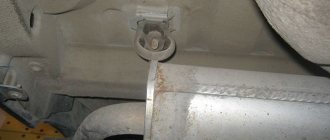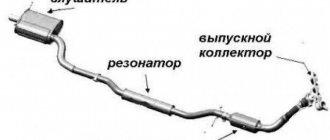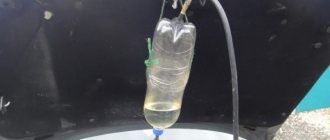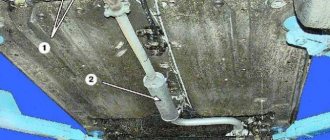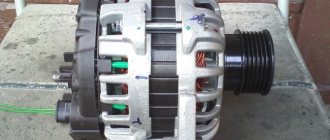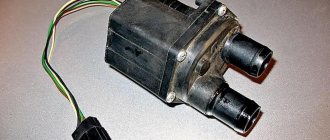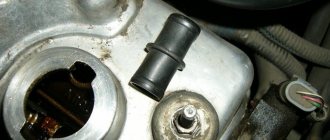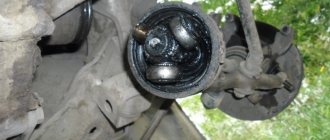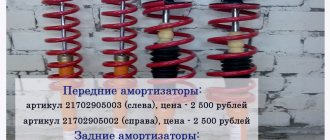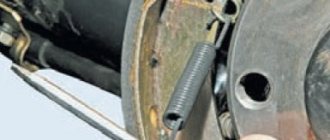The system for removing waste exhaust gases in a car is an important technical complex that performs many necessary functions: reduces toxicity in exhaust gases, reduces noise from vehicle operation, prevents the penetration of toxic products of fuel combustion into the passenger compartment of the car, participates in regulating the operational characteristics of the car, Thanks to the creation of the necessary resistance of exhaust gases, it creates a certain image of the car brand (timbre of sound, detail of appearance). On the Lada Priora, in this regard, replacing the resonator is not such a rare operation.
Step-by-step instructions for replacing the resonator on a Lada-Priora with your own hands
Actions to replace a faulty resonator of this model are carried out quite quickly, without any difficulties arising in their sequence.
Car repairs are best done using an inspection hole or a lift. As a last resort, you can lift the car body with a jack. To carry out repairs, you will need a set of the following tools:
- special penetrating lubricant;
- keys, heads at “13”;
- knob or ratchet;
- chisel;
- hammer.
A hammer and chisel are needed if the fastening nuts cannot be unscrewed from the manifold studs due to burning of the metal. To dismantle the resonator, you must carefully cut the nuts with a chisel, being careful not to damage the studs.
For self-repair, the step-by-step brief instructions for the work are as follows:
- All existing threaded connections are treated with a special penetrating lubricant to facilitate their unscrewing.
- The clamp, which is the fastening element of the resonator and muffler pipes, is equipped with two nuts that can be unscrewed.
- The loose clamp is dismantled.
- The above pipes (resonator and from the muffler) are disconnected.
- The special metal sealing ring is removed.
- The nuts that secure the pipe from the resonator to the catalyst are loosened. It should be noted that some car models are not equipped with this component. In this case, this stage of action is replaced by measures to disconnect the resonator tube from the collector.
- The resonator rises slightly.
- The hanging pillows are removed from the metal bracket. The rear cushion is released first. Next, the front one is dismantled.
- Further and final unscrewing of two nuts is carried out for fastening to the catalyst structure.
- The special spring washers are dismantled.
- The bolts are removed. In case of repair of a car model without a catalyst, both fasteners are removed together with the springs.
- The resonator is dismantled.
Replacing the resonator on a Priora, installation
Design and malfunctions of the Lada Priora exhaust system
As usual, to change the resonator, you need a pit, or even an overpass. To carry out the replacement yourself, you need to prepare several tools and materials:
- a set of keys;
- penetrating lubricant;
- chisel;
- knob;
- hammer.
The algorithm for repairing the exhaust gas system on a Priora car is as follows:
- Before work, drive the machine onto an overpass or pit, stop the machine, apply the handbrake, and begin work.
- Treat the threads in the connections of the spare part with other parts of the muffler with lubricant - this will allow the fasteners to be detached as smoothly as possible.
- Remove the bolts securing the clamps that hold the exhaust system in place. Smoothly remove the clamps while holding the parts.
- Remove the rubber O-ring from the pipe.
- Loosen the nuts that secure the catalyst. Lift the spare part pipe. Release the two cushions that smooth out vibrations caused by the operation of the machine.
- Remove the remaining two mounting nuts and then the spring washers.
- Remove the system components.
- Before installing a new spare part in place of the old one, prepare new bolts - if the threads still had to be knocked off, it is better to have new bolts on hand. Clean all connections - with the muffler, with the exhaust manifold - from soot that interferes with good adhesion of the metal.
- Prepare new rubber hangers to support the new part; old ones wear out very quickly - especially if the replacement is carried out due to obvious signs of malfunction. Install a reinforced gasket to the muffler, securing it with bronze bolts - this will only increase the resistance to high temperatures.
How to remove the old resonator
Before starting any work on the exhaust system, it is necessary to drive the car onto an overpass or inspection pit. You can use a lift or even a regular jack - you need to make sure that the car is securely fixed in this position.
And also, before starting work, it is recommended to lubricate all threaded connections that will need to be unscrewed. This is necessary so that the old fasteners can be dismantled as quickly as possible. After 10 minutes you can begin the main work:
- First, the connection between the pipe and the exhaust manifold is unscrewed. This is the most difficult place to reach in the exhaust system. You can try to remove the nuts with a wrench. But in most cases, even WD-40 is not able to soften the reliability of the connections. Therefore, you have to resort to using a chisel to move the nuts out of place.
- If even after the chisel the nut cannot be unscrewed, you will have to cut it off with a hammer and chisel, while being careful not to touch the stud itself on which it stands.
- After unscrewing or removing the nuts, you can move one edge of the resonator to the side. You can start dismantling from the other edge.
- Next, the nuts of the coupling clamp are easily unscrewed.
- If the nuts suddenly become very stuck, you can cut them off with a chisel.
- The resonator is disconnected from the exhaust system pipes; all that remains is to remove its body from the rubber suspensions.
- After which the product is pulled out from under the car.
Direct-flow muffler for Priora
Which muffler should I put on the Priora?
High beam lamps for Lada Priora: the best models and step-by-step replacement instructions
The need to repair the exhaust system arises for any car. The action of high temperatures, high humidity, reagents and salt on the roads in winter, all this leads to the destruction of the metal from which the exhaust parts are made. Let's take a closer look at the questions: which muffler to buy for a Priora (VAZ 2170 - VAZ 2172), which resonator to install on a Priora, how many parts does a muffler on a Priora consist of, and how much does the exhaust system on a Priora cost in current realities?
There are options for cheap Ukrainian-made mufflers, there are spare parts that are more expensive than foreign ones, and you can install a direct-flow (sports) exhaust. If you are faced with the problem of repairing the exhaust, we will look at how to replace the muffler on a Priora below in various possible variations.
What parts does the Priora exhaust system consist of?
The exhaust system of a Priora car (VAZ 2170 - VAZ 2172) consists of the following components:
collector pipe: as standard, it has a catalyst or particulate filter, which allows it to meet the environmental safety requirements of the car Euro - 3, and later, in the latest models, Euro - 4; the collector is connected through flanges to the resonator
The resonator is equipped with an integrated corrugation, which allows you to reduce the level of vibration in the exhaust, this is important for Priora; the resonator is connected to the muffler through a clamp, this allows you to quickly remove the Priora muffler if it needs to be replaced; from the rear of the car, from the outside, you can see the muffler exhaust pipe, which many motorists decorate with an aesthetic nozzle; all the main components of the Priora exhaust system are connected using pipes into a single, closed and sealed system.. It has become quite common to replace the manifold with catalyst with a regular spider (exhaust pipe) familiar to classic VAZs.
In this case, environmental standards are not complied with absolutely, but the catalyst does not “strangle” the engine. By reflashing the electronics, you get an increase in power and better vehicle dynamics at certain engine operating modes
It has become quite common to replace the manifold with a catalyst with a regular spider (exhaust pipe) familiar to the classic VAZ. In this case, environmental standards are not complied with absolutely, but the catalyst does not “strangle” the engine. By reflashing the electronics, you get an increase in power and better vehicle dynamics at certain engine operating modes.
Most often in Priora there is a need to change the muffler. If an unpleasant loud sound appears when the engine is running, then the most likely cause is a burnout in the muffler. A situation often arises when the exhaust system cracks when the Priora accelerates. The most common reason for this situation is the destruction of the internal partitions in the muffler bank. At certain engine speeds this has a noticeable effect on the sound. In any such situations, the best solution would be to install a completely new muffler on the Priora.
Roar, shooting, condensation and other reasons to look under the car
It's easy to spot muffler problems. It is difficult not to notice extraneous sounds coming from under the car, or a sharp change in the tone and volume of the response to pressing the gas. It is not uncommon to notice fluid leaking or even splashing from the exhaust pipe. All these are signs of malfunctions, but do they all indicate problems in the exhaust system?
Fluid in the muffler
Fluid dripping from the exhaust pipe is a common occurrence. However, it is worth distinguishing what kind of liquid it is. If it's water, there's nothing wrong with it. When the ambient temperature changes, moisture from the air condenses on the surfaces of the muffler. If a steel muffler is used, this can lead to corrosion, but usually the Priora exhaust system uses aluminized steel or stainless steel, which means that damage from water will be minimal. In cases of heavy accumulation of water, experienced motorists usually drill a drainage hole in the “barrel” of the muffler.
If there is excessive accumulation of water in the muffler, in winter you may encounter icing of the exhaust pipe
If antifreeze drips from the exhaust pipe, the fault should be looked for not in the muffler, but in the engine. The reason may be wear of the cylinder head gasket, as well as depressurization of the block itself. Antifreeze in the exhaust pipe is a symptom of serious problems, and if it is detected, you should immediately diagnose the engine.
Pops and shots from the exhaust pipe
Popping noises coming from the muffler indicate a malfunction. However, this is also a malfunction of the engine, not the exhaust system. Shots or pops from the exhaust pipe indicate that the mixture of air and gasoline does not burn out in the cylinder block, which means that when you hear them, you should check the spark plugs and spark plug wires, as well as the serviceability of the gas distribution mechanism. Problems with combustion of the mixture are not a symptom of a muffler failure, but they can be its cause.
Article on the topic: Replacing a pump on a “classic” with your own hands
Video: this is what pops from the muffler sound like
Knocking from under the car
A knocking sound from under the bottom of the car while driving or rattling from vibrations is an unpleasant phenomenon. The muffler may touch the gas tank or the underbody. There are several possible reasons for this.
- First of all, check the rubber muffler hangers. Their wear leads to loosening of the entire exhaust system. These mounts are sold at most auto parts stores. Their price usually does not exceed 100 rubles per piece. Replace the suspension with new ones and the knocking will stop.
- It is worth checking whether the clamp connecting the main muffler and the additional muffler is loose. If necessary, replace the fastening bolts and nuts. For replacement, it is best to use fasteners made of heat-resistant materials.
- Using the wrong model of muffler with pipe bends that differ from the original spare part can lead to contact between the exhaust pipe and various components of the car: the body, the gas tank and even the suspension. Be careful when choosing a muffler.
Lowered the car - the muffler is knocking
When installing a short-travel suspension on a Priora, tuning enthusiasts often encounter a situation where the suspension beam, which has moved closer to the body, begins to touch the muffler. This problem can be solved by replacing the muffler hangers with new ones of a more suitable shape.
Loud roar at revs
If a vehicle's exhaust system loses its seal, it cannot effectively reduce the volume of exhaust emissions. In this case, the exhaust often takes on a “pseudo-sports” sound. Therefore, if the muffler growls, you should look for a gap in it. It can be on the muffler body or on the pipes. It makes sense to check the connections and their fastenings. If the metal from which the muffler is made is of low quality, the exhaust pipe may burn out due to temperature. Time, corrosion and the quality of domestic roads cause damage to the exhaust system.
Pressure and temperature can cause holes
A burnt or broken muffler is easiest to replace. If depressurization occurs at the joints, you can limit yourself to replacing the sealing ring and the necessary fasteners.
Standard muffler - article number and price
We change the alternator belt on a Lada Priora car ourselves
The VAZ 2170 Priora is equipped by the factory with spare part item number 2170-120010. Made of light sheet steel with a thickness of 0.8-1.1 mm. Connecting inlet pipe with a diameter of 48mm. Inside the muffler chamber (an oval tank - popularly known as a barrel) there is a series of parallel chambers for the last stage of dampening the force of the sound wave of the exhaust gases. The exhaust pipe allows you to install different types of muffler attachments to add uniqueness and change the sound characteristics of your car's exhaust. The price of such a standard muffler is in the range of 1200-1600 rubles. Of course, you can go much further.
The feasibility of installing a new stainless resonator
This is how Priora sounds without a resonator
For the purpose of high-quality replacement and long-term use, it is necessary to install a stainless resonator on the VAZ 2170 Priora. Installation of such a resonator occurs in a standard place. Lada Priora replacement of the resonator eliminates the need for modifications and improvements to the exhaust system.
This type of resonator has two parts, namely internal and external. Both parts are stainless steel (AISI 316 steel). AISI 316 steel is a common analogue of 10Х17Н13М2.
The standard resonator, which requires replacement, has dimensions of 250x100. Pipe size – 51x1.5. The pipe is also made using AISI 316 steel.
How to install new
After the old product has been dismantled, there is no need to rush to immediately put a new one in its place. First, you need to clean as much as possible of carbon deposits and dirt from all joints with the muffler and exhaust pipe. This will ensure better sealing of the entire system.
Further work is carried out in reverse order:
- The new resonator is suspended on rubber hangers. If the rubber bands are stretched out, it is better to replace them with new ones, this will improve the fixation of the resonator.
- Then you need to connect the resonator to the muffler.
- Additionally, it is recommended to install a new reinforced gasket between them and secure it with bronze bolts, since only such connections will withstand high temperatures.
- Then you can begin installing the resonator with the receiving pipe.
- At the joints it is also better to install new nuts made of heat-resistant metal alloys.
Video: step-by-step replacement algorithm for VAZs of various modifications
Choosing a resonator is a problem for many car owners. Moreover, for the Lada Priora you can choose both original products and models from the Lada Kalina - there is no difference in design. You can save significantly on installation costs if you replace the resonator yourself. The procedure is quite simple and does not require special preparation. This is the only way the owner can guarantee the reliability of the fastenings and functions of the new resonator.
Replacement
- Unscrew the upper and lower fasteners of the clamp holding the resonator and muffler. Moreover, if we unscrew the top one completely, then the bottom one is a little more than half unscrewed.
- We disconnect the resonator and muffler, remove the seal.
- We remove the rubber cushions, slightly lift the muffler up, and dismantle it.
- We install the new muffler in the reverse order.
This is interesting: Diesel engine fuel system - how does it work?
System breakdowns
There can be many problems with the exhaust system. As a rule, repair is not possible; replacement of elements will be required. Let's take a closer look at them.
- Rust and system destruction due to corrosion. Accumulating condensate especially contributes to this problem.
- Inability to muffle noise. Typically, the malfunction is caused by the destruction of the internal partitions of the main muffler.
- Breakage of fasteners. A characteristic symptom of the problem is a knocking sound from the muffler and the appearance of vibration.
- Oxygen sensor malfunction.
The standard method for solving certain problems is to replace the element. In some cases, temporary solutions are possible, but if the muffler is “burnt out” or rusted, unfortunately, you simply cannot do without installing a new part.
The system for removing waste exhaust gases in a car is an important technical complex that performs many necessary functions: reduces toxicity in exhaust gases, reduces noise from vehicle operation, prevents the penetration of toxic products of fuel combustion into the passenger compartment of the car, participates in regulating the operational characteristics of the car, Thanks to the creation of the necessary resistance of exhaust gases, it creates a certain image of the car brand (timbre of sound, detail of appearance). On the Lada Priora, in this regard, replacing the resonator is not such a rare operation.
Main malfunctions of the Lada Priora muffler
The main reasons for replacing or repairing this part of the exhaust system are often burnout, rupture of the tank with loud bangs inside, loss of integrity, and deformation of structural parts. Loud roar when operating at high speeds, impacts on the body. An important factor in the failure of the Lada Priora muffler is metal corrosion, which occurs when the protective coating is lost as a result of overheating and condensation of water vapor on the walls.
Fluid in the muffler
accumulation of liquid in the cavity of the barrel or, as experienced car enthusiasts joke, “drips from the end”) is a fairly common phenomenon
It is important to find out what kind of liquid collects inside. Often the reason for this is water condensation formed from the difference in the operating temperature of the unit and the external environment
It has a negative effect on models made of iron-zinc steel that are poorly protected against corrosion. Models made of steel with a share of aluminum or stainless steel are less susceptible to this influence. Many people find a way out by drilling a drainage hole in the corner of the tank. If you find antifreeze or antifreeze in the liquid, it’s time to sound the alarm. Malfunction in the tightness of the cooling system of the car engine (loss of integrity, wear of the cylinder head gasket, depressurization of the cylinder block). You should immediately check the operation of the cooling system and eliminate the cause to avoid further negative consequences.
Loud roar at revs
The sound of the exhaust gases changes when the engine speed reaches over 3000. The reason for this behavior is often the burnout of the partitions inside the resonator, the middle part of the exhaust system, or a clogged exhaust catalyst. Loss of joint density, structural integrity as a result of corrosion, burnout of individual elements, cracks at the joints of parts. All this indicates the end of the service life of the spare part. The only reliable solution is to replace the faulty system unit. Eliminating these defects with a hammer and a welding machine is a temporary solution.
Roar, shooting, condensation and other reasons to look under the car
It's easy to spot muffler problems. It is difficult not to notice extraneous sounds coming from under the car, or a sharp change in the tone and volume of the response to pressing the gas. It is not uncommon to notice fluid leaking or even splashing from the exhaust pipe. All these are signs of malfunctions, but do they all indicate problems in the exhaust system?
Fluid in the muffler
Fluid dripping from the exhaust pipe is a common occurrence. However, it is worth distinguishing what kind of liquid it is. If it's water, there's nothing wrong with it. When the ambient temperature changes, moisture from the air condenses on the surfaces of the muffler. If a steel muffler is used, this can lead to corrosion, but usually the Priora exhaust system uses aluminized steel or stainless steel, which means that damage from water will be minimal. In cases of heavy accumulation of water, experienced motorists usually drill a drainage hole in the “barrel” of the muffler.
If there is excessive accumulation of water in the muffler, in winter you may encounter icing of the exhaust pipe
If antifreeze drips from the exhaust pipe, the fault should be looked for not in the muffler, but in the engine. The reason may be wear of the cylinder head gasket, as well as depressurization of the block itself. Antifreeze in the exhaust pipe is a symptom of serious problems, and if it is detected, you should immediately diagnose the engine.
Pops and shots from the exhaust pipe
Popping noises coming from the muffler indicate a malfunction. However, this is also a malfunction of the engine, not the exhaust system. Shots or pops from the exhaust pipe indicate that the mixture of air and gasoline does not burn out in the cylinder block, which means that when you hear them, you should check the spark plugs and spark plug wires, as well as the serviceability of the gas distribution mechanism. Problems with combustion of the mixture are not a symptom of a muffler failure, but they can be its cause.
Video: this is what pops from the muffler sound like
https://youtube.com/watch?v=4nj7G3So-6U
Knocking from under the car
A knocking sound from under the bottom of the car while driving or rattling from vibrations is an unpleasant phenomenon. The muffler may touch the gas tank or the underbody. There are several possible reasons for this.
- First of all, check the rubber muffler hangers. Their wear leads to loosening of the entire exhaust system. These mounts are sold at most auto parts stores. Their price usually does not exceed 100 rubles per piece. Replace the suspension with new ones and the knocking will stop.
- It is worth checking whether the clamp connecting the main muffler and the additional muffler is loose. If necessary, replace the fastening bolts and nuts. For replacement, it is best to use fasteners made of heat-resistant materials.
- Using the wrong model of muffler with pipe bends that differ from the original spare part can lead to contact between the exhaust pipe and various components of the car: the body, the gas tank and even the suspension. Be careful when choosing a muffler.
Lowered the car - the muffler is knocking
When installing a short-travel suspension on a Priora, tuning enthusiasts often encounter a situation where the suspension beam, which has moved closer to the body, begins to touch the muffler. This problem can be solved by replacing the muffler hangers with new ones of a more suitable shape.
Loud roar at revs
If a vehicle's exhaust system loses its seal, it cannot effectively reduce the volume of exhaust emissions. In this case, the exhaust often takes on a “pseudo-sports” sound. Therefore, if the muffler growls, you should look for a gap in it. It can be on the muffler body or on the pipes. It makes sense to check the connections and their fastenings. If the metal from which the muffler is made is of low quality, the exhaust pipe may burn out due to temperature. Time, corrosion and the quality of domestic roads cause damage to the exhaust system.
Pressure and temperature can cause holes
A burnt or broken muffler is easiest to replace. If depressurization occurs at the joints, you can limit yourself to replacing the sealing ring and the necessary fasteners.
Which model is better to choose
Choosing a new device is almost always a challenge. Firstly, I want to save money on its purchase. Secondly, in order to avoid paying attention to the operation of the exhaust pipe for a long time, it is advisable to buy a more or less high-quality product.
Today, several models for the Priora are presented in car markets and auto stores at a variety of prices. The cost of any product depends on its quality. So, on free classifieds websites you can buy a used resonator for about 450–550 rubles. However, at a low price, the car enthusiast acquires an additional problem: the resource of such an element has already been exhausted and it does not have long to serve.
The middle price category includes resonators produced by AvtoVAZ - Lada Image. They are made of durable metal alloys and can last for quite a long time - up to 5 years. Their average price ranges from 1500 to 2500 rubles. The cost increases according to the thickening of the metal wall and the number of perforated tubes inside the housing.
The Lada Image resonator is capable of providing factory quality at an affordable price
And also in the category of “middle peasants” are Ecris resonators. They come in two types - regular and aluminized. Their performance indicators and service life are almost the same as those of Lada Image.
The Phobos models are recognized as the highest quality. They are made using rolling technology, that is, they have excellent tightness and durability characteristics. Depending on the financial condition of the buyer, you can choose a regular housing or a device with a corrugated compensator, which will reduce exhaust noise to a minimum and will serve for more than 10 years. True, such models cost 3500–4000 rubles.
The Phobos resonator is chosen by drivers who are accustomed to trusting only proven brands
When choosing a new resonator, one must proceed from practical convictions: the product must meet all safety requirements. Some car enthusiasts try to make a resonator for the Lada Priora with their own hands: this is a fairly simple procedure, however, a homemade element is not always completely sealed and removes gases from the manifold well.
A reliable and high-quality resonator will ensure stable removal of gases from the manifold and prevent the penetration of poisons into the cabin
General information about the principle of operation and design of the resonator
The operating principle of this component is based on the use of completely closed cavities located near the pipeline, which are connected to the latter using a number of special holes.
As a rule, its body contains two cavities of different volumes, which are mechanically separated by a special solid partition. The existing holes, as well as closed individual cavities, are resonators that excite oscillations with their own frequency.
The directions of propagation of noise waves with a resonant frequency can change, due to which its effective noise damping occurs. The effect occurs due to friction in the holes present in the exhaust of gas particles.
The structure consists of two parts: the outer shell, as well as the internal structure. The product can be made entirely of stainless steel AISI 316, which is an analogue of the common version 10Х 17Н 13М2. Standard dimensions correspond to 250 mm x 100 mm. The pipe is also made of high-quality stainless steel and has dimensions of 51 mm x 1.5 mm.
The internal filling of the body of a standard resonator is simple, and the design uses features that take into account the propagation of noise waves
Features and Benefits
The main task of the exhaust system resonator of the Lada Priora car is to qualitatively dampen the sounds of engine operation, as well as vibrations arising during operation.
With the loss of the original qualities of this component, there is a sharp increase in vibration, as well as the noise characteristics of the car’s power unit, reaching their peak values at maximum engine speed. In fact, this is a regular muffler that performs the same functions, which is why it is called a middle muffler based on its location in the exhaust system.
Such a muffler has the following advantages:
- effective damping of low noise frequencies;
- absence of significant barriers to the passage of gases;
- use does not reduce the overall cross-section of the exhaust system.
Causes of possible breakdowns, conditions for replacing parts
The main reasons for replacing the resonator on a car are as follows:
- burning of the body in the center of the structure;
- burnout or mechanical damage to the joints with the exhaust manifold (catalyst) or muffler;
- corrosion processes.
The resonator can burn out anywhere or undergo unwanted corrosion
As a rule, the following reasons are to blame:
- sudden changes in external temperature;
- contact of exhaust system components with reagents, salt, and moisture;
- accumulation of moisture condensate in the resonator;
- the presence of various chemical aggressive compounds in the resonator.
A faulty resonator when driving is a source of discomfort for the driver and passengers of the car. Other road users will also have a negative reaction to the operation of a car with a similar malfunction, since the movement of such equipment will be accompanied by loud noise.
Thus, signaling factors about a malfunction of the exhaust gas exhaust system of vehicles, in particular the Lada-Priora resonator, are:
- increased noise when the engine is running;
- a noticeable decrease in the power of the power unit (decreased traction, acceleration);
- intermittent engine operation (jumpy idle speed);
- entry of exhaust gases into the passenger compartment of the car;
- presence of black deposits on parts (smoke soot).
Due to its design features, full-fledged repair measures for this part are impractical, so experts recommend replacing the failed component.
Malfunctions
The Priora exhaust system suffers mostly from corrosion processes that occur due to condensation: vapors settle on the hot surface, which, as the metal cools, turn into destructive drops. Overheating also causes system destruction. The main faults include the following:
- reduced noise reduction;
- breakdown of sensors;
- broken fastenings;
- mechanical defects of parts.
A decrease in the ability to suppress noise occurs due to damage to the partitions. This malfunction is usually indicated by rattling sounds when the engine is turned on. Whatever the malfunction, it requires an urgent procedure for replacing the muffler, because if you postpone this action until later, the problem can worsen and lead to very unpleasant consequences, because the muffler not only reduces the noise level, its second job is to protect against penetration toxic fumes into the cabin, which can lead to poisoning of the driver and passengers. In addition, the muffler affects the operation of the engine, maintaining its power. That is why it is important to approach the issue of replacing the muffler with the utmost care.
Resonator installation
Installation of the part is carried out in the reverse order. Compliance with the required sequence, as well as the use of the original resonator for the Lada Priora, ensures simple, easy installation of the part
Particular attention must be paid to connecting the new resonator to the muffler pipe. It is recommended to replace the special metal sealing ring between these components, as well as the clamp itself, with new ones in order to ensure the required level of sealing of the connection, reliability and rigidity of the structure
The fastening elements are clamped sequentially, without distortions in the level of the resonator and muffler pipes.
The Lada Priora resonator in the exhaust system is located, as a rule, after the collector pipe (pants) or after the catalyst
On the Lada-Priora car, it is recommended to install a resonator, which is made from stainless steel options. This circumstance allows you to significantly increase the service life of this part. Installation of such a resonator is carried out on its standard mount and no additional modifications or improvements are required in the exhaust system of the car.
Experts do not advise trying to install resonators that are intended for use on other car models. For example, you should not try to install a resonator from the domestic brand Lada-Kalina on a Lada-Priora. This is due to a number of reasons that will subsequently have a negative impact on the technical and operational characteristics of the car, and such a replacement will only turn into a waste of money, time and effort.
When installing resonators from other cars on the Lada-Priora, extraneous noise and unwanted vibration may be observed when the engine is running, which is caused by defects in the bends of the shape and size, as well as differences in the fastening of the part to the suspensions of the car body. All these points are determined by the relevant norms and standards at the manufacturer.
The main advantages of the part include:
- reduced exhaust noise compared to factory;
- the thickness of the partitions is 2.0 mm;
- integrity and high-quality assembly of the housing (pulse argon arc welding is used);
- high-quality processing of welds on the body, which includes several stages and consists of their mechanical processing, subsequent polishing and special acid passivation.
Twin Pipe Types
The following options are currently most popular among domestic car enthusiasts:
- bifurcated outlet installed after the muffler;
- parallel installation of two pipes with mufflers behind the resonator;
- system with 2 resonators and the same number of mufflers.
Moreover, in the latter case, a twin pipe can also extend from each of them. As you can see, each option has its own advantages and disadvantages, so the choice remains with the car owner.
In this article we will tell you how to make the simplest double exhaust for a Priora. In this scheme, the pipe will be routed after the muffler, that is, the option is purely decorative.
This solution can be implemented in several ways. It will be easiest to weld a branch from the main pipe. However, this option has many disadvantages, which, however, do not affect the quality of the motor. But the fact is that at high speeds less gases will come out of the added pipe. That is, any knowledgeable person will understand that the dual exhaust is pure decoration.
It is better to assemble a structure in the shape of a slingshot, in which pipes of equal length and cross-section, directed in different directions, are installed after the muffler.
Mufflers VAZ 2110-(Tenth family)
Silencers by dozens are also divided into 2 body types:
- Muffler VAZ 2110, 2111 – sedan and station wagon
- Muffler VAZ 2112 – hatchback
And here too there are subtypes: new
and old style
. But unlike the Lada Samara, subtypes play a significant role here. Old style mufflers have a hook-shaped mount. Approximately, they were produced until 2007 (but not a fact - this is a VAZ, baby), then they came with pin-type fastenings.
What is a resonator
When people hear the loud roar of a car passing by, they think that the engine is running so loudly. Although the reason for the sharp sounds when applying gas lies not in the engine, but in the muffler of the car.
A resonator is one of the parts of a car's exhaust system. It is he who is responsible for gas removal and reduction of exhaust noise. In addition, it lowers the exhaust temperature and dampens gas pressure.
If you look at the entire diagram of the exhaust pipe, the resonator will be located approximately in the middle. And if a sharp and powerful sound comes from the pipe while driving, then this mechanism is solely to blame.
Node device
The resonator consists of two chambers and a perforated pipe that passes through both chambers
The mechanism from the Kalina can also act as a resonator for the Lada Priora. It has the same volume and the same design, making these elements considered interchangeable.
Device
As we said above, the Priora exhaust has three main elements. Let's look at each of them in more detail:
- leading muffler. Elliptical device made of high-strength metal. In the inner part there are partitions necessary to soften the sound. There are pipes connected to it in front and behind. It is fixed to the body with the help of special pillows that prevent vibration;
- additional muffler. It is located near the manifold and is fixed to the body similarly to the leading structure. The connection to the leading muffler is made using hinges, which helps prevent damage to the bottom and lighten the load on the device;
- collector. Necessary for collecting exhaust from the engine and to prevent damage to the metal by harmful reagents. Connects to the receiver using flanges.
So, we have figured out the structure of the system, then we will talk about its main problems.
Main components of the Priora exhaust system
As already mentioned, this is not one element, but several:
- Timing (gas distribution system) exhaust valves.
- Exhaust manifold with particulate filter (catalyst).
- Oxygen sensor (Lambda probe) 2 pieces.
- Middle part with resonator.
- Tail section with muffler.
Each of these parts must be considered separately.
Release of gases in the cylinder head
This is part of the operation of the gas distribution mechanism. A full description of this mechanism is a separate issue of engine operation. It is enough to mention here that the 8 exhaust valves open in exhaust mode and the piston pushes the exhaust gases into the system. Namely, into the exhaust manifold.
Catalyst or particulate filter in the exhaust manifold
This is one of the most complex and expensive components of the entire exhaust gas system. Essentially, this is a device for afterburning unburned gasoline particles using catalysis. For this purpose, the thin walls of the longitudinal filter honeycombs are made of a special material. Contacting them, gasoline burns (figuratively). The output is ordinary water.
Set of Lambda probes for Euro-3 system
What is Euro 3 standard? In fact, this is the level of purification of car exhaust gases. It is according to the levels of vehicle access to Europe that these systems are distributed. There are several levels:
- Euro level.
- Euro 2 threshold.
- Euro-3 (basic for Priora).
- Euro-4 (Subsequent models and the latest “Priors”).
- Euro-5.
In the first option, a particulate filter was added to the exhaust system. It is mentioned above. But in system No. 2, electronics control has already been connected. A special, rather complex and expensive sensor was developed. Lambda probe or oxygen sensor. Thanks to a special coating, its resistance changes its value depending on the saturation of the exhaust gases with carbon monoxide. That is, carbon monoxide.
To more accurately understand the meaning of the Lambda probe, it is worth briefly describing the history of Euro standards. So.
To reduce toxicity, an afterburner was installed in the exhaust system (the particulate filter described above). This was the Euro system. Further, with the development of the electronic component of the control system, the idea of exhaust quality control came. And installed 1 oxygen sensor. It was placed in the system directly into the collector. Before the afterburner. This allowed us to make adjustments to the gas saturation table in the program. The system with one sensor was called Euro-2.
However, savvy motorists quickly realized that the particulate filter, which reduces engine power, can simply be thrown out. Which is what they began to do with success. Then, after the afterburner, another Lambda probe was inserted into the system. And he already informed the computer that the filter was not working. And accordingly, he again cut back on fuel. This became the new Euro 3 standard. Well, Euro 4 and 5 are just a modification of the software and replacement of fuel to the European level, respectively. The latter, if nothing interferes, should be carried out in Russia by the end of 2022.
This is what the oxygen sensors in the Priora exhaust system are for.
What is the purpose of the resonator in the Priora exhaust device?
It is also called an auxiliary muffler. It is an exhaust system pipe bent at an angle and having an extended section in one place. This makes it possible to initially smooth out the sound vibrations escaping from the engine when releasing gases.
The auxiliary muffler is located immediately behind the manifold and catalyst. And immediately behind it comes the muffler itself.
On some Priora models, two parts, the resonator and the main muffler, are made as a single unit. But the collapsible design is more convenient both in operation and in repair.
